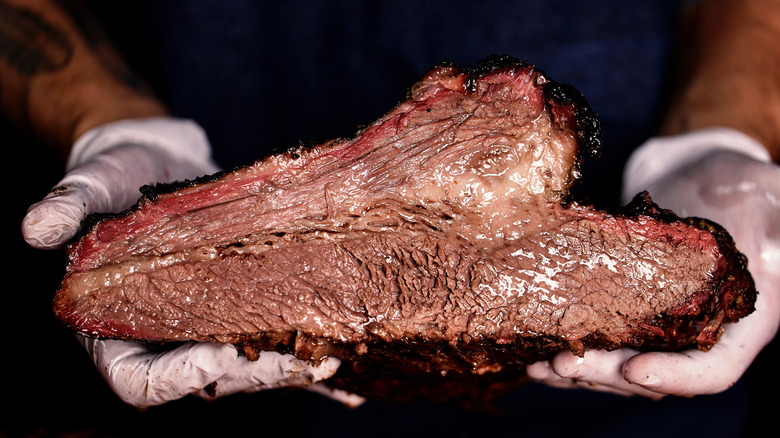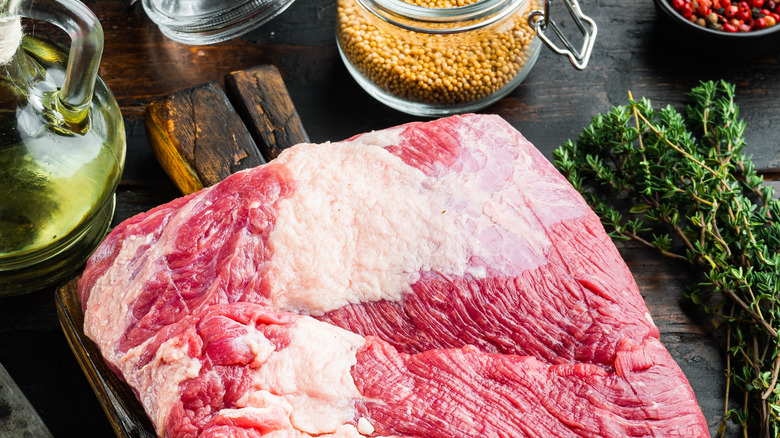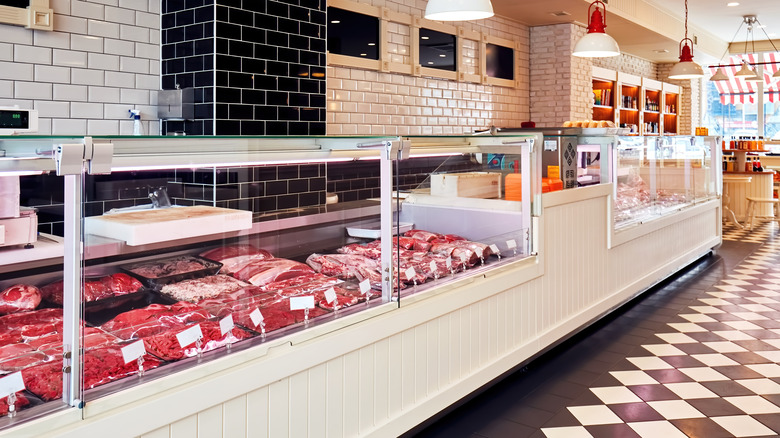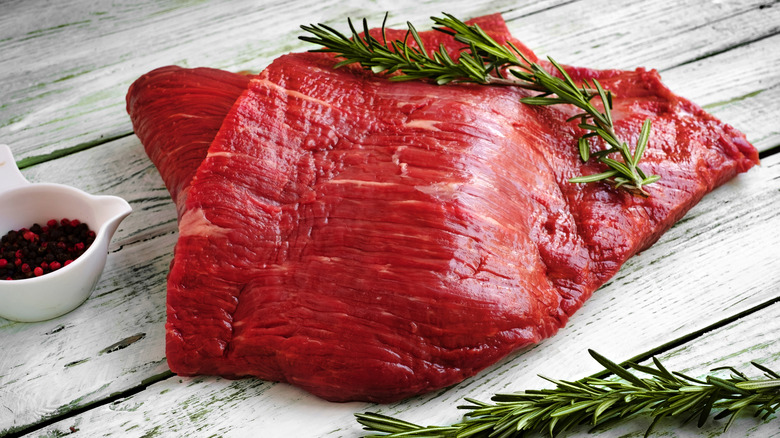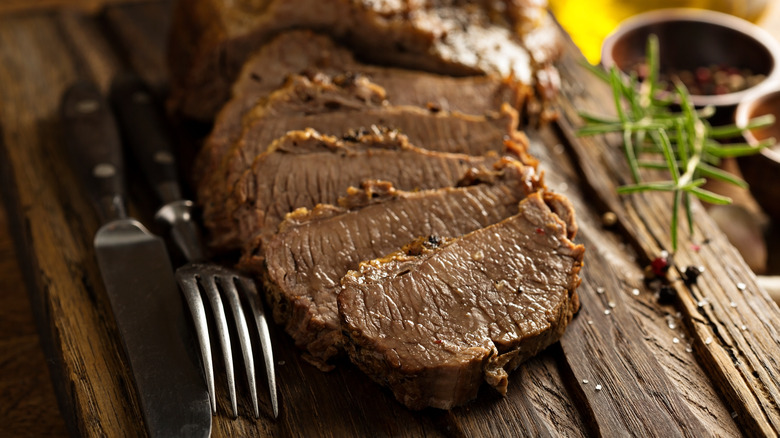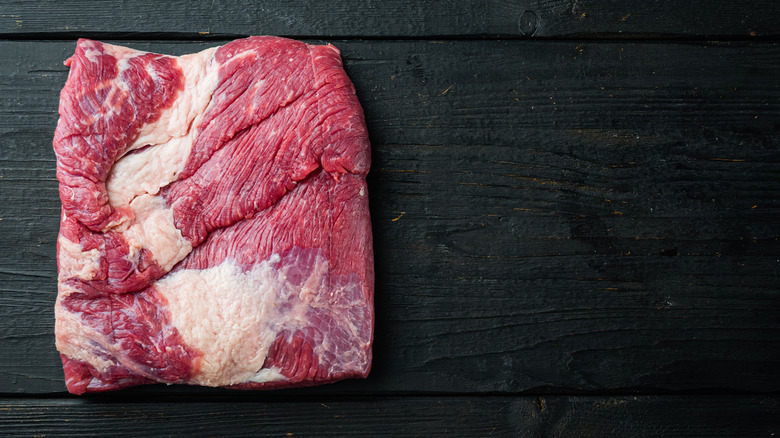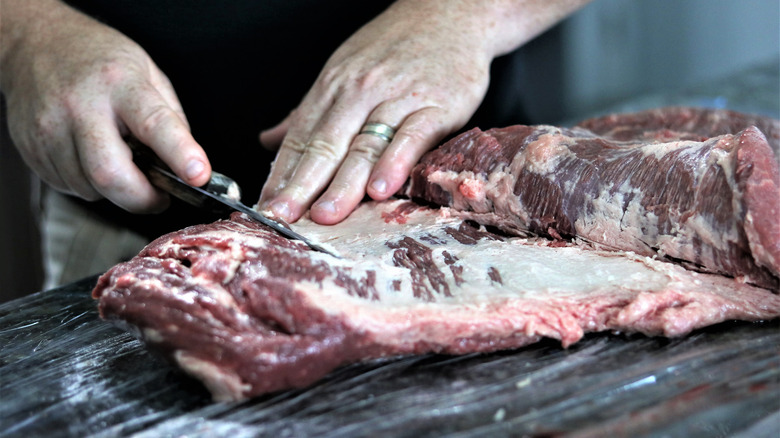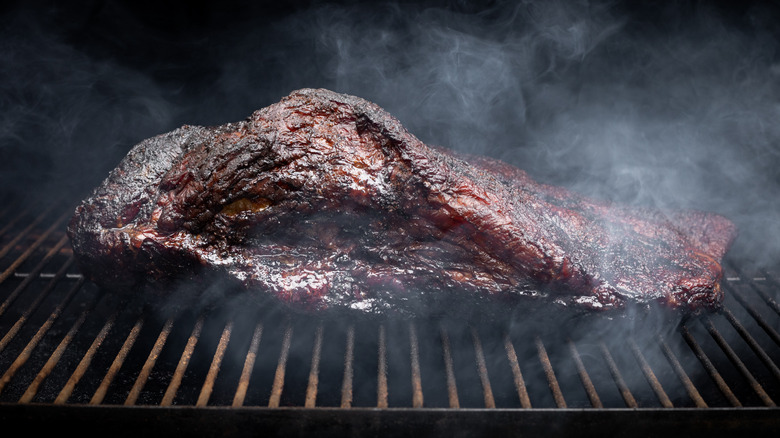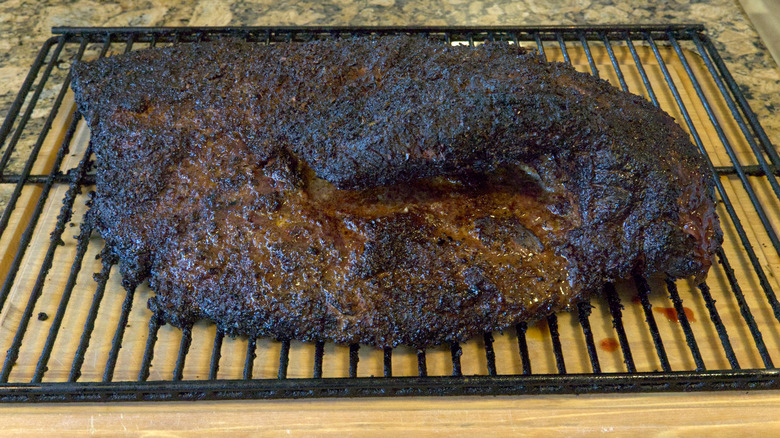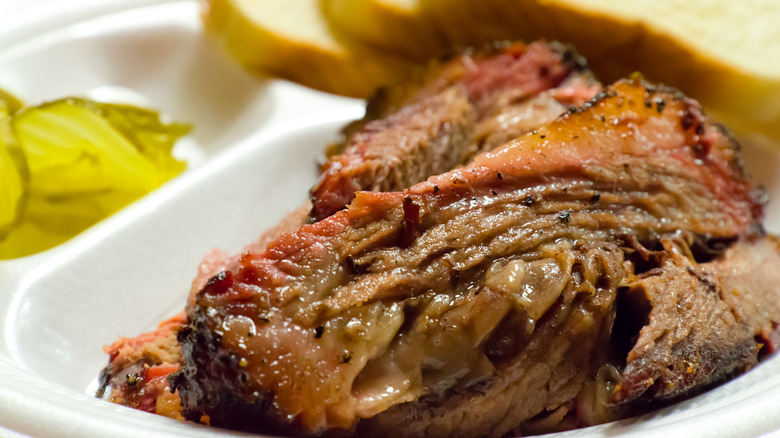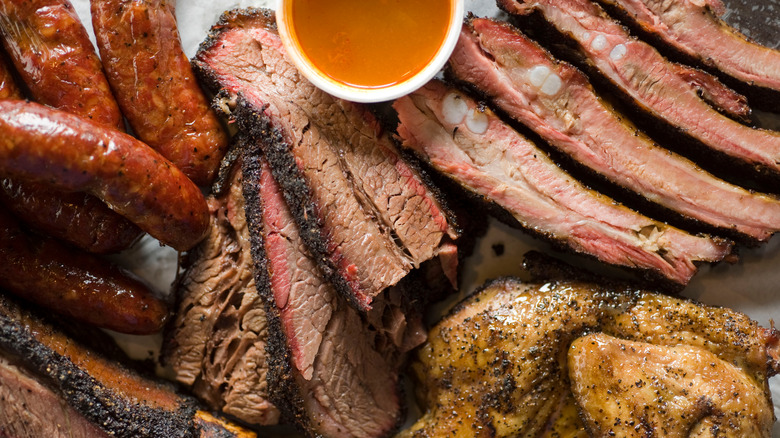Everything You Need To Know About Brisket
For some people, brisket is no less than the holy grail of barbecue and food in general. It's the first thing many barbecue lovers order at a BBQ joint, and pitmaster legends are made on a person's ability to make an amazing brisket. Even if you're a relatively newbie who's curious about brisket, there's a lot to know. Everything from what type of brisket to order at a restaurant, whether or not you should add sauce, and even how to select, trim, and cook brisket at home for yourself contains a world of information.
There's a lot to love about brisket, whether you're ordering out or smoking at home. A cheap cut of meat made tender with low and slow cooking — traditionally, slow smoking that takes many hours — this primal cut can offer a lot of flavor and feed a crowd. And while brisket is derived from red meat that can be high in fat content, research indicates it could be a better choice healthwise than some other options.
Read on to learn everything you need to know about enjoying brisket, whether you're hitting a famed BBQ joint or slow smoking your own at home.
Brisket is a primal cut of beef or veal
Where exactly does brisket come from? According to The MeatStick, brisket is a primal cut of beef, which means it's one of the first cuts to come off the animal during the butchering process. Other primal beef cuts include the loin, flank, and rib. Brisket can also be further refined to other forms of meat. According to The Kitchn, corned beef and pastrami are actually types of brisket.
Specifically speaking, the brisket cut is the cow's lower chest area. A brisket cut can be taken from veal as well, a type of meat that usually sourced from young male dairy calves. A highly used muscle that supports much of the cow's body weight as it stands or moves, the brisket cut is lower in fat content than some other beef cuts, though there is a fat cap that can be trimmed. The muscles include both the superficial and deep pectorals. Due to the strength and continued use of these muscles, this cut contains a lot of connective tissue that can be tough if the brisket isn't prepared in a way that tenderizes the meat.
A butcher shop is your best source for brisket
Brisket is commonly available at grocery stores, butchers, and meat markets. Hey Grill Hey notes that a grocery store brisket is generally a small, pre-trimmed cut weighing up to five pounds. This cut can be convenient for some recipes, especially if you're not planning to feed a crowd, but you might find the quality lacking somewhat. Instead, you'll typically find the best brisket from a dedicated butcher.
At a local butcher shop, you can get a full packer brisket, also known as a whole brisket. This type of brisket is untrimmed and much larger than what you'd get at the grocery, usually up to about 20 pounds. While you'll need to do some trimming (or you can ask the butcher to do it for you), a full packer brisket will likely give you more bang for your buck.
And considering the work that goes into preparing a brisket, you might prefer to take on a larger cut to make it worth your while anyway. Some leftovers never hurt anyone, especially when we're talking about brisket. At a butcher shop, you'll also be able to select the grade of beef you prefer, which influences the price, fat content, and marbling on the meat, ultimately giving you more control over the final product.
There are two cuts of brisket: flat and point cut
Brisket is a large cut of meat and is typically cut into two pieces: the flat and the point cut (via RealSimple) Though these two cuts come from the same primal cut of beef, they have different properties and flavors that can significantly affect the final form of your brisket.
Generally, you'll find the flat cut available at most grocery stores. It's a lean, easy to slice cut. If you're braising brisket, a flat cut can be a good choice for retaining moisture. However, it doesn't have quite the flavor profile of the point cut. That's because the point cut, also known as the deckle point, is more heavily marbled with fat. That makes it moister on its own, not to mention pretty flavorful thanks to the fat already present in the cut. A point cut will also generally fall apart as you cook or serve it. It's generally a superior choice if you're planning to smoke your brisket, as the higher fat content can keep this cut properly moist as it spends hours in the somewhat drier environment of a smoker.
Brisket might not be as unhealthy as it looks
Brisket is red meat and the truth is that red meat is known to increase health risks. There's a "clear link between high intake of red and processed meats and a higher risk for heart disease, cancer, diabetes, and premature death," according to Harvard Health. However, the school points out that a relatively low intake also naturally correlates with lower health risks. A healthy limit when it comes to red meat is about two to three servings each week. So, moderation is key.
As you choose your servings of red meat each week, brisket could actually be one of the healthier options. According to Texas A&M researchers (via Wide Open Country), brisket's high levels of oleic acid can be beneficial. They produce high levels of HDLs — that is, the good cholesterol that may help to lower your heart disease risk — and it lowers LDLs, the "bad" type of cholesterol.
However, if you're using high heat to cook your brisket, you should be aware that it can cause carcinogens to form. One way around that is to simply use a marinade. According to Wide Open Country, using spices like thyme, sage, and garlic in your marinade can prevent those high-heat carcinogens from forming.
Untrimmed brisket can be surprisingly cheap
Don't let the package price of a brisket fool you. It's actually pretty cheap, according to The Spruce Eats. Grocery store flat cuts can be up to about five pounds and it's not unusual to see a full packer brisket weighing about 15 pounds at the butcher. Now, that's a lot of meat, and you'll probably end up paying more per package for brisket than you would for a couple of steaks. However, a closer look at the numbers will undoubtedly show you that the price per pound is generally much lower for brisket than other types of beef.
That can make brisket a true bargain choice if you're feeding a crowd and have the time to prepare it properly. And another budget tip: ask your butcher to help you find a brisket that has enough fat content to offer a rich, moist flavor, but not so much that you're paying too much for fat that will need to be trimmed off.
There's an art to trimming brisket
If you're buying a full packer brisket, you'll need to trim it down before cooking. According to grilla grills, the main task when it comes to trimming a brisket is removing the large deposits of fat. Yes, while you want some fat to remain on the brisket to add flavor and moisture as it renders down throughout the brisket cooking process. However, some of the fat that comes on a brisket simply won't render down and should be removed first.
You're looking for the fat that has a leathery appearance and feels especially dense compared to the other fat deposits on the brisket. Be sure to remove those heavy layers of fat before cooking, because they will only add to your cook time and you'll have to remove it after the fact. Otherwise, you or someone else is likely to end up with a bite of unpleasant fat and not the delicious meat you were hoping to enjoy.
When it comes to trimming fat off a brisket, you're generally just removing surface fat and the point end fat on both sides. That's the fat that separates the point and flat cuts of the brisket, for reference. Ultimately, if it's a large enough fat deposit that you can pinch it with your fingers and cut it out, it's probably worth removing.
Smoking is the preferred way to cook a brisket, but it's not the only option
There are a handful of ways to cook a brisket, but whatever method you choose, it should be low and slow. Per The Spruce Eats, brisket is a pretty tough cut of meat, so it needs to cook at a low temperature for a long period of time to make it just right. This process breaks down the cut's muscle fibers more effectively than a fast, hot cook like you'd do for a more naturally tender cut.
You can braise or cook beef brisket in an Instant Pot, for one. You can even cook it in the oven. However, smoking a brisket will offer a Texas-style flavor that's absolutely worth a try at least once in your life. Of course, smoking a brisket can take several hours depending on its size. If you're looking at brisket as a weeknight dinner, opting for braising or the Instant Pot can get you to brisket time faster, though you should still expect it to take at least two to three hours. A proper smoked brisket is probably best reserved for a special occasion.
Smoked brisket needs at least an hour to rest
After you've smoked, braised, or cooked your brisket for hours and inhaled the flavors that await, you're probably ready to dive right in and eat. Bad news: you've got another hour to wait on it (via Wide Open Eats). While theoretically, yes, you could cut into a brisket fresh off the smoker and eat it, that would be a mistake.
According to Wide Open Eats, as your brisket cooks, the moisture in the muscle fibers of the brisket moves toward the surface of the meat. When you rest it, that gives the moisture time to settle down and redistribute. If you don't rest it, that moisture will run out as you slice the meat, making a mess and wasting lots of precious flavor.
The solution? Wait about an hour before you start slicing brisket. Yes, really, you need to wait that long. As a large cut of meat, brisket needs more time to redistribute the moisture than other cuts. You can keep your brisket covered on the counter to let it rest, but it's better if you retain some heat another way, all so you're not eating cold brisket. One method is to wrap the cooked brisket in a clean towel and place it in a cooler until you're ready to slice and serve.
At a BBQ joint, you can usually order lean or moist brisket
When you visit a BBQ restaurant, you may be asked if you want lean or moist brisket. The flat, leaner cut is the standard here. It's typically served with barbecue sauce to offset potential dryness. Some brisket lovers just want a leaner cut of meat, usually for health reasons.
But if you're looking for a lot of flavor (again, courtesy of some fat), opt for the moist option. It's generally much more tender than the lean option. However, it is naturally much higher in fat content and calories, which is something to keep in mind if you're watching your intake. Some spots offer the option to get a little of both if you want some balance. That can offer the best of both worlds, so you can get some of the flavor of fatty brisket but fill up on lean brisket that's less troublesome for your diet.
Saucing brisket is considered an insult to some pitmasters
Smoking brisket is a labor of love, to say the least. It requires lots of hot, smoky work in a barbecue pit, often tended to overnight, even in the heat and humidity of summer. As pitmasters put in dedicated hours to bring out the slow-smoked flavors of their brisket, they might cringe if they see you drown that carefully cultivated flavor in barbecue sauce. In fact, in Texas, The Dallas Morning News reports that it's considered a serious insult to add sauce to brisket. But if you just like sauce, or you're dealing with dry, overcooked, or extra lean brisket, you might want to add some to balance it out with moisture.
If you're adding sauce to your brisket, look for one with a little sweetness and some spice, but not so much that it will overpower the flavor of the meat. Don't bother with sauces that add a synthetic smoky flavor, as that should already be apparent in the cut of the meat, not the sauce. However, if you're eating the product of a true pitmaster, you probably won't need even a bit of sauce, anyway.
